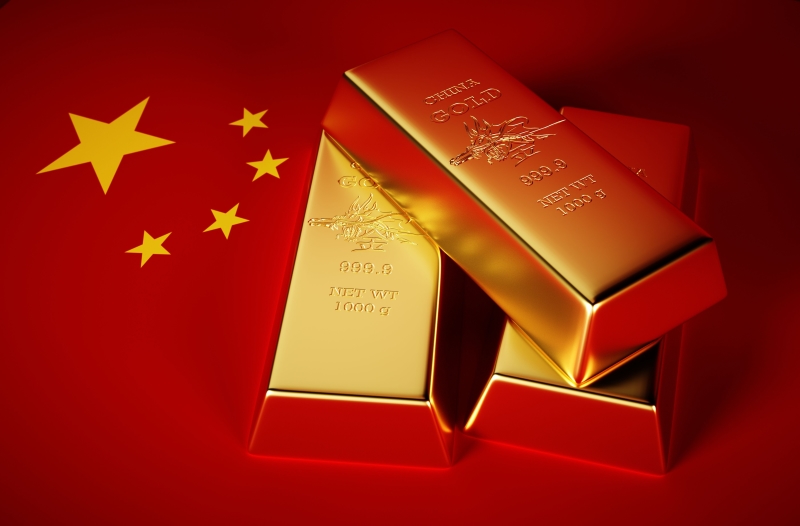China's Gold Market in 2023 Demand Improved And Premiums Rose

(January 18, 2024 - Ray Jia Senior Analyst, China World Gold Council)
Highlights
- China’s economic recovery in 2023 was not a smooth sail and consumers remained cautious in spending
- While the performance of major local assets disappointed, the Shanghai Gold Benchmark Price PM (SHAUPM) in RMB, surged by 17% in 2023
- Gold withdrawals from the Shanghai Gold Exchange (SGE) totalled 1,687t in 2023, 7% higher y/y
- Chinese gold ETFs attracted RMB5bn (+US$654mn) in 2023 and their total asset under management (AUM) rose to RMB29bn (US$4bn), the highest ever. Holdings increased by 10t to 62t
- The People’s Bank of China (PBoC) has reported non-stop gold purchases in 2023, lifting their gold reserves by 225t to 2,235t by the year end
- As a result of robust gold demand, stable production and falling imports after late 2022, the local gold price premium jumped to unseen levels in 2023
The economy: improved but scarred
China’s economic resurgence in 2023 was turbulent. As COVID-related restrictions were dropped at the end of 2022, a notable rebound in consumer spending and the return to normalcy in all industries fuelled China’s growth in early 2023.1 But the momentum didn’t last, as Q2 and Q3’s growth failed to meet market expectations. The sentiment improved mildly in Q4, pushing 2023’s annual GDP growth to 5.2%, above the 5% target set by policy makers.
A key factor behind 2023’s economic volatility was consumers’ reluctance to spend during most of the year. Surveys from the People’s Bank of China (PBoC) show that local depositors’ intent to save has been floating around a record high all through 2023.2 And combined with low consumer confidence, savings growth outpaced borrowings significantly for a second year running
The COVID pandemic may have ended in 2022, but its long shadow impacted consumer behaviour in 2023: domestic consumption was weaker than expected and inflation hovered around zero for much of the year.3
Meanwhile, other factors, such as the housing sector slowdown and the monetary policy divergence between China and other major markets, which led to a widening interest rate spread and weighed on the local currency, also impacted the nation’s growth.
Gold: shining bright
Gold outperformed major RMB assets in 2023
Gold fared well in 2023. Supported by geopolitical risks, sizable central bank purchases – and intensifying expectations of major central banks lowering rates– gold, in US dollars, delivered a 14% return.4 And the SHAUPM in RMB rose by 17% during the year, topping the performance of all major local assets. This strength in the RMB gold price relative to its USD peer was mainly a result of the local currency’s weakness. Both benchmarks saw their highest daily close on 28 December 2023.5
As of 31 December 2023. Based on MSCI World Index, Au9999, ChinaBond Composite Index, CSI Money Market Fund Index, CFETS RMB Index, Wind China Commodity Index, WTI Active, Bloomberg Global Commodity Index and CSI 300 Index. All calculations in RMB.
Wholesale gold demand bounced higher
Gold withdrawals from the SGE totalled 1,687t in 2023, 7% higher y/y and 3% above the five-year average. The rebound was mainly thanks to the relatively low base of 2022, China’s economic recovery in 2023, and gold’s increasing allure during the year.
Gold found the limelight in 2023; its eye-catching performance and strong local and global central bank purchases led to extensive coverage by local media. And gold’s attractiveness was further boosted by the increasing need of households to preserve value: the local gold price’s outstanding performance drew their attention when the currency other major assets weakened.
We believe too that the ongoing innovation from gold jewellery manufacturers – widening their product ranges and adapting to changing consumer taste – helped improve demand.
But compared to 2021, which benefited from a strong economic recovery and relatively upbeat consumer sentiment, wholesale demand in 2023 was 3% lower. A materially higher local gold price last year may have also held back consumers and investors. And due to affordability issues, as well as the industry’s dazzling innovation, lightweight products have gained increasing traction, adding pressure to tonnage gold demand. Furthermore, as pandemic-related restrictions were lifted at the end of 2022, consumer spending on activities such as travel and entertainment rebounded markedly, denting budgets for gold.6
Chinese gold ETFs led global inflows
Chinese gold ETFs attracted RMB5bn (+US$654mn) in 2023, leading global inflows. Their total AUM reached RMB29bn (US$4bn) at the end of 2023, the highest ever in RMB terms. Holdings increased by 10t to 61.5t.
This rising appetite for gold ETFs among local investors was driven by:
- The sizable gain in the local gold price and the disappointing performance of other local assets
- Economic and geopolitical uncertainties around the globe
- The PBoC’s non-stop announcements of gold purchases
- Increasing promotional efforts from gold ETF providers.
China’s gold reserves kept rising
The PBoC has announced consecutive gold purchases since November 2022. In 2023, the central bank announced a 225t increase in their gold reserves, which reached 2,235t by the end of December. Gold now accounts for 4.3% of the nation’s official foreign exchange reserves. And during the past 14 months China’s gold reserves have risen by 287t.
A notably higher local gold price premium in 2023
The Shanghai-London gold price premium rocketed during 2023. The premium reached an annual average of US$29/oz, or 1.5% – the highest in history. On a monthly average basis, September’s US$75/oz (3.9%) was the largest. And the daily record was set on 14 September 2023, when the local gold price premium reached US$121/oz, or 6.4%.
*As of 31 December 2023. We compare the LBMA Gold Price AM to SHAUPM because the trading windows used to determine them are closer to each other than those for the LBMA Gold Price PM.
*Data between Q1 2008 and Q3 2023, net gold supply is calculated by subtracting the current quarter’s gold withdrawals from the SGE and announced central bank gold purchases from the previous quarter’s mine production and imports. Due to data availability, imports prior to 2015 are proxied by gold imports from Hong Kong while China Customs’ official imports are used after that date.






